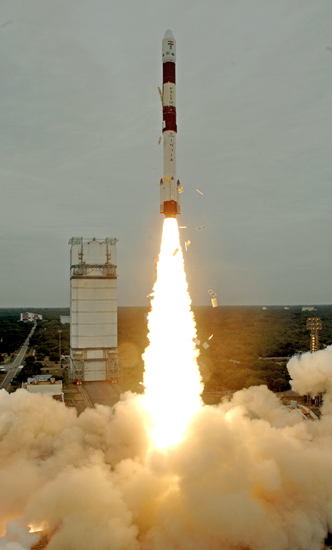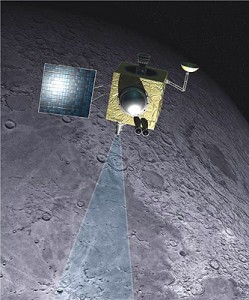
India’s Polar Satellite Launch Vehicle PSLV C-21 lifts off Sunday, Sept. 9, 2012, from a launch pad in southern India, marking the 100th mission for the Indian Space Research Organization. (Photo: ISRO)
India’s space program celebrated an historic milestone Sunday after successfully launching its 100th space mission.
The Indian Space Research Organization (ISRO) put a French satellite and Japanese micro-satellite into polar orbit aboard its Polar Satellite Launch vehicle (PSLV).
The mission’s payload included SPOT 6, an observation satellite from France’s space agency (CNES), and Proiteres, a 15-kg microsatellite built by students and faculty at Japan’s Osaka Institute of Technology (OIT).
ISRO began its venture into space back in April 1975 with the launch of its first satellite, Aryabhata, aboard the Soviet Union’s Cosmos-3M launch vehicle.
Indian Prime Minister Manmohan Singh, an early proponent of India’s space program, witnessed the launch and congratulated ISRO scientists and engineers as well as personnel from France and Japan for the successful launch of their satellites.
“Questions are sometimes asked about whether a poor country like India can afford a space programme and whether the funds spent on space exploration, albeit modest, could be better utilised elsewhere,” Singh said. “This misses the point that a nation’s state of development is finally a product of its technological prowess.”

Artist’s rendering of India’s Chandrayaan-1 spacecraft which went to the moon in 2008. (Photo: ISRO)
ISRO’s other key accomplishments include the Chandrayaan-1, India’s first unmanned lunar orbiter/probe, which was launched in 2008. The spacecraft’s Moon Impact Probe was released from the orbiter and sent to crash into the moon’s surface at the Shackleton Crater near the lunar South Pole. The orbiter, meanwhile, circled the moon 3,400 times for 341 days, sending observational data back to Earth.
Looking to the future, the Indian space agency is planning a manned space flight program and another mission to the moon with its planned Chandrayaan-2 spacecraft, featuring a lunar lander/rover.
A few weeks ago, Prime Minister Singh, announced plans for one of its most ambitious projects yet, a mission to the Red Planet with the MangalYaan Mars orbiter.





















If India of all countries will successfully launched a space program of this magnitude after an unmanned shuttle in 2008 Naija where are you?